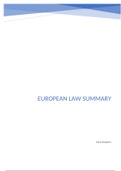Samenvatting
Summary European Law
Summary of the Book 'European Union Law' by C. Barnard, S. Peers (Oxford University Press, 2017) Specific content of the Summary (divided over the different lectures) Chapter 2 Chapter 3 Chapter 5 Chapter 6: sections 1-5 Chapter 9 Chapter 10: sections: 1, 2, 3.1 (3.1.1-3.1.2-3.1.3- 3.1.4), 3.2 (3....
[Meer zien]














